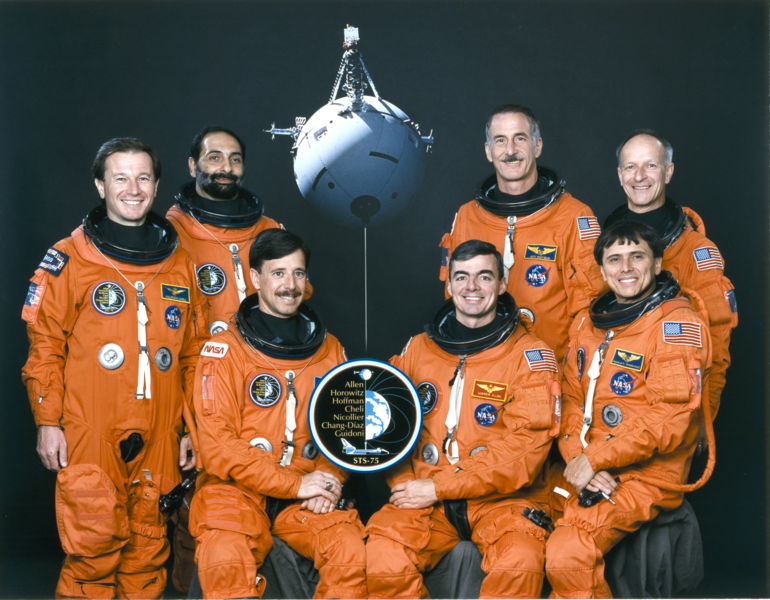
Twenty years ago, Space Shuttle Columbia rocketed into orbit carrying one of the most unusual experiments on record: the Tethered Satellite System (TSS). Conceived by the late Professor Guiseppe Colombo of Padua University, it was intended to demonstrate the “electrodynamics” of a conducting tether in an electrically charged region of Earth’s atmosphere, known as the ionosphere. It was envisioned that Colombo’s idea might ultimately lead to systems that would use tethers to generate electricity for spacecraft, employing our planet’s magnetic field as a power source. Furthermore, by reversing the direction of the current in the tether, the force created by its interaction with the magnetic field could potentially put objects into motion, thus boosting a spacecraft’s velocity without the need for precious station-keeping fuel and counteracting the effects of air drag.
In the late 1980s and early 1990s, this was particularly appealing for the designers of Space Station Freedom and its eventual successor—today’s International Space Station (ISS)—as a means of compensating for atmospheric drag on the colossal outpost. Additionally, it was hoped that the concept could lead to the development of devices to trail scientific platforms far below orbital altitudes in difficult-to-study zones, such as the fragile ozone layer over the South Pole. Other applications for tethers included serving as extremely low-frequency antennas, capable of penetrating land and seawater, and perhaps generating artificial gravity or delivering payloads into higher orbits.
During the eight-day STS-46 mission in July 1992, the TSS underwent its first demonstration in Earth orbit. Unfortunately, it achieved only partial success, when its 12.6-mile-long (20.5-km) tether twice became snagged on a bolt in the deployment reel mechanism and refused to unroll more than about 850 feet (260 meters). Nevertheless, the mission proved the concept sufficiently for a reflight to be proposed. In March 1994, NASA Administrator Dan Goldin and Italian Space Agency (ASI) Special Administrator Professor Giampietro Puppi confirmed that the reflight would occur in February 1996. “NASA and ASI long have planned this reflight, but a formal commitment awaited U.S. Congressional approval for NASA to spend Fiscal Year 1994 funds,” it was reported. “NASA and ASI completed a study last year of the jointly-developed TSS and confirmed their judgement of its usefulness as a unique shuttle-based experiment carrier.” A two-week flight was required to allow additional time for deployment and several days of ionospheric research.
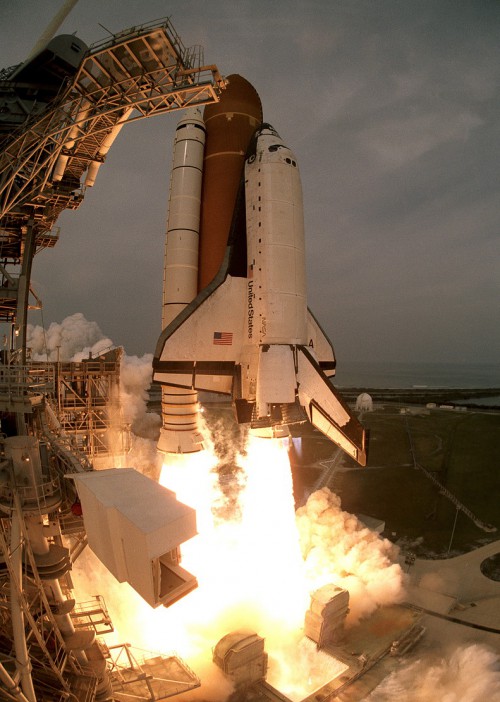
Most of the original STS-46 crew was kept together for the reflight. Andy Allen, who had flown as pilot of the first mission, was assigned to command its second flight. He was joined by payload commander Franklin Chang-Díaz and mission specialists Jeff Hoffman and Claude Nicollier, all three of whom had also flown aboard STS-46. Hoffman had served as payload commander for the first flight and would exchange roles with Chang-Díaz on the second mission.
“It was unbelievably embarrassing when we discovered the cause of the tether jam,” Hoffman told a NASA oral historian, “so there was a significant amount of redesign.” Having said this, he believed there was a “strong scientific case” to refly TSS and felt that the inclusion of himself, Allen, Chang-Díaz, and Nicollier, together with payload specialist Umberto Guidoni—who served in a backup role on STS-46—was critical to mission success. “The astronaut office decided that the core of the payload crew … should refly,” he said, “which was great, because we were all good friends. There’s always a certain stress when husbands get assigned to another flight, but since the families all knew one another, I think that made it a lot easier and more pleasant for everyone.” Additionally, NASA carried over STS-46 Lead Flight Director Chuck Shaw onto the second mission. The assignments came in three phases, with Chang-Díaz announced as payload commander in August 1994, Guidoni joining the crew in October, and the other five members named in January 1995.
Seated alongside Andy Allen on Columbia’s flight deck for STS-75 was Scott Horowitz, nicknamed “Doc,” the first shuttle pilot to hold a PhD. With Claude Nicollier hailing from Switzerland, and two other crewmen—mission specialist Maurizio Cheli and payload specialist Umberto Guidoni—from Italy, STS-75 became the first shuttle flight to feature three European Space Agency (ESA) crew members. Unusually, the crew was split into three shifts for the TSS deployment operation, reverting to a Spacelab-style dual-shift system after the conclusion of activities with the tethered satellite. The “red” team consisted of Horowitz, Cheli and Guidoni, the “blue” team of Chang-Díaz and Nicollier, and a unique “white” team of Allen and Hoffman. The third, staggered shift was added to enable the astronauts to operate a suite of instruments on the TSS to gather real-world data about how conducting tethers might be used to generate electrical power in space. After the deployment operations, it was planned for Allen to rejoin the blue team and Hoffman the reds.
The satellite which formed the primary focus of these three shifts was a 5.2-foot-diameter (1.6-meter) sphere, weighing 1,140 pounds (517 kg), with an outer shell of aluminum alloy and coated with an electrically conducting layer of white paint. It was, however, far more than just an oversized metallic football. Piercing its shell were windows for Sun, Earth, and charged particle sensors, a connector for the umbilical tether and doors providing access to its on-board batteries. Extending from one side of the TSS was a long, fixed instrument boom, whilst a shorter antenna sprouted from its other side. To assist with the thermal control of the satellite, the interior of the spherical shell was painted black.
If one were to break open the TSS, like an egg, the interior comprised two compartments: a payload module, housing its scientific instruments, and a service module for its subsystems. Additionally, in the centre of the spherical shell was a pressurised nitrogen tank, which provided propellant for the satellite’s 12 cold gas manoeuvring thrusters. If the satellite could be termed an engineering marvel, the 0.08-inch (2 mm) conducting tether which connected it to a support mast in Columbia’s payload bay was nothing less. Surrounding its Nomex core was electrically conducting copper wire, insulated with Teflon and coated with ultra-strong braided Kevlar-29. Jacketing the latter was an outer coat of braided Nomex, which protected it from abrasion and the corrosive effects of atomic oxygen in Earth’s rarefied upper atmosphere. During deployment, the tether was unreeled from a mechanism, affixed to a Spacelab pallet and the Mission-Peculiar Equipment Support Structure (MPESS) in the payload bay.
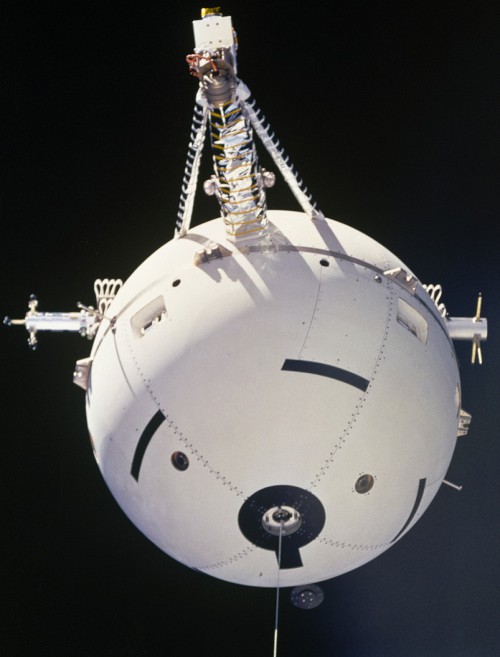
Essentially, the mechanism took the form of a four-sided erectable tower, resembling a small broadcasting pylon, which unfolded slowly out of its storage canister using a series of rollers. As the canister rotated, fibreglass batons popped out of their stowed positions to form cross members (“longerons”) which supported the tower’s vertical segments. The tower thus deployed to a height of 38.7 feet (11.8 meters) above the shuttle’s payload bay, so that when the satellite was released there existed no risk of it hitting any part of the surrounding structure. (“The complexity of the experiment is extreme,” Commander Andy Allen noted before launch.)
That, however, was the easy part. Deploying the tower and even the TSS itself had already been done by the STS-46 crew; what Allen and his men planned to do on their 14-day mission in February 1996 was finish the task by getting the satellite and tether to their full 12.6-mile (20.5-km) length and demonstrating Guiseppe Colombo’s concept. In fact, no fewer than 12 experiments were planned during the reflight—designated TSS-1R—of which six had been provided by NASA, five by the Italian Space Agency (ASI), and one by the U.S. Air Force. Several of these experiments were mounted on the MPESS. Two were designed to investigate the dynamics of the tether during its deployment phase, another provided theoretical support in the area of electrodynamics, a couple of others employed ground-based equipment to measure electromagnetic emissions from the satellite, and seven others stimulated or monitored the entire assembly as it reeled out of the payload bay. Nearly 14 miles (22 km) of cable occupied the deployment mechanism, although only 12.6 miles (20.5 km) would actually be unraveled.
“Arrivederci, au revoir, auf wiedersehen and adios,” Allen radioed cheerily from Columbia’s flight deck on 22 February 1996 as he and his crewmates lowered their visors and prepared for launch. “We’ll see you in a couple of weeks.” Without further ado, and after a perfect countdown, they thundered aloft precisely on time at 3:18 p.m. EST. Unfortunately, the first portion of their ascent did not prove to be quite as perfect. Four seconds after liftoff, Allen and Horowitz spotted a potentially serious problem on their instrument panel. One of the three Space Shuttle Main Engines (SSMEs), it seemed, was running at just 40-percent thrust—far lower than the 104 percent it should have been producing in the seconds after launch. The pilots checked with Mission Control, who verified that their telemetry indicated that all three engines were performing normally at full power and Columbia continued safely into orbit. Of course, if the (ultimately erroneous) instrument readout had been for real, it would have required Allen and Horowitz to perform a Return to Launch Site (RTLS) abort back at the Shuttle Landing Facility (SLF). “We had a couple of moments there that we got a little adrenaline rush,” Allen said later. It looked like a “bad run” in the simulator.
Safely in orbit, the crew divided into their respective shifts and blue team members Chang-Díaz and Nicollier set to work activating the TSS-1R support equipment in readiness for a planned deployment of the satellite early on 24 February. Before turning in at the end of his first shift, Hoffman also tested the reel motor and latching mechanism which secured the spherical satellite onto its docking ring atop the still-folded deployment tower. By the 23rd, with less than 24 hours to go before deployment, the mission had encountered its first spate of problems. A computer relay, responsible for sending commands to the satellite, experienced an electrical overload. Known as a Smart Flexible Multiplexer-Demultiplexer, or “Smartflex,” the relay had to be switched to a backup component. Although the backup performed satisfactorily, Mission Control opted to spend several hours evaluating it before giving the go-ahead to begin TSS-1R deployment activities.
Next, a laptop computer on the shuttle’s aft flight deck encountered difficulties and was exchanged for a spare, which itself behaved sluggishly. Nevertheless, in the early hours of 24 February, the methodical procedure to activate the experiments associated with the satellite got underway. Firstly, the experiments were switched on individually, then together, in an effort to isolate the computer problems. By 3 a.m. EST, all experiments were up and running and data was successfully transmitted through the Smartflex to the laptop and from thence to Mission Control.
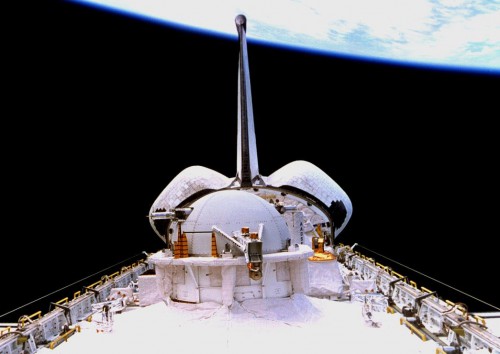
It was at around this point that managers decided to postpone the deployment until 25 February to gain additional confidence and testing time with the Smartflex. Although it had remained stable thus far, it was desirable to allow engineers to better understand its behaviour after several unexpected crashes and restarts. The delay also gave them ample opportunity to develop work-around procedures should the Smartflex encountered difficulties during the deployment procedure. According to Mission Scientist Nobie Stone, it was like learning to walk before running. One of these confidence-building tests involving “mapping” Earth’s charged particle environment, which varied dramatically as Columbia orbited the globe in periods of sunlight and darkness every 45 minutes.
During this time, Nicollier activated the Tether Optical Phenomena (TOP) experiment, developed by Lockheed Martin’s Palo Alto Research Laboratory in California. This employed a hand-held, low-light-level television camera to provide visual data in support of tether dynamics and optical effects created by the satellite. Through the overhead flight deck windows, Nicollier acquired stunning views of atmospheric airglow over the South Pole. Elsewhere, the Theory and Modeling in Support of Tether (TMST) investigation provided theoretical electrodynamic assistance to TSS-1R. Meanwhile, as preparations got underway, other experiments underwent tests.
One of these was an electron gun, called the Shuttle Electrodynamic Tether System (SETS), which generated a beam in support of the science experiments. It provided voltage and current readings from the tether throughout the deployment process. Multiple test beams were fired from the electron gun on 24 February to acquire data on the shuttle’s ionospheric environs. A day later than originally planned, at 3:45 p.m. EST, the deployment procedure got underway and proceeded without a hitch under the watchful eyes of Hoffman and Guidoni. The satellite pushed itself away from its docking ring on top of the mast, using its cold gas thrusters, and was expected to reach its maximum distance over a 5.5-hour period. “The satellite is rock-solid,” Hoffman reported excitedly. It was expected that, after reaching its maximum extent, the satellite and tether would remain extended for 22 hours of studies. A slow “creep” back toward Columbia, precisely choreographed from Mission Control, would have produced a docking back onto the mast at 1:43 p.m. EST on 26 February.
Orbital dynamics resulted in TSS-1R initially deploying “upward” at a rate of just 5.9 inches (15 cm) per minute, and an angle 40 degrees “behind” the shuttle’s path. Its motion was carefully controlled by electric motors, which reeled out the tether, and by the satellite’s thrusters. An hour into the deployment, it eclipsed the 850 feet (260 meter) limit of its predecessor. Gradually, the deployment rate increased to 1 mph (1.6 km/h), then slowed briefly in order that the 40-degree angle could be reduced to just five degrees. This placed the satellite almost directly “above” the crew cabin. Throughout the process, Columbia’s thrusters were disabled to avoid inducing oscillations in the tether. Beginning at a distance of 2,000 feet (610 meters), the satellite undertook a series of very slow rotations in support of the science investigations. The deployment of the tether increased to a peak speed of 5 mph (8.1 km/h) around 8 p.m. EST, by which time the satellite had reached a distance of nine miles (15 km).
Shortly afterwards, things started to go wrong.
The second part of this article will appear tomorrow.
Be sure to “Like” AmericaSpace on Facebook and follow us on Twitter: @AmericaSpace




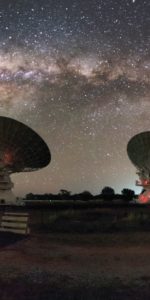
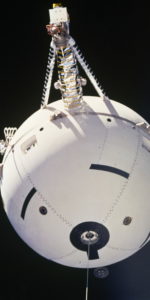
The real news , or just engineering course .. still wondered about what kind of space it ??
http://goo.gl/odUYWd